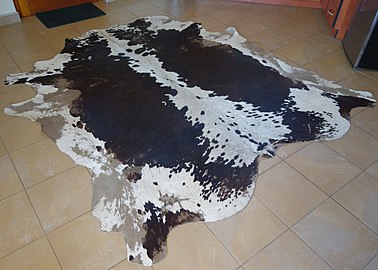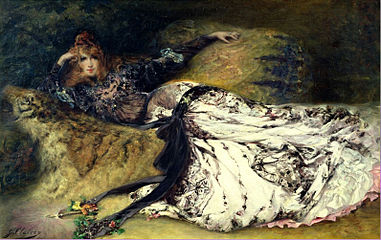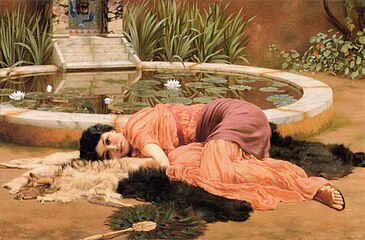Fur rugs

A fur rug , also known as a fur template , is, in the narrower sense, a fur carpet made from a single fur in its natural fur shape. In the times when they were particularly in use, rugs made of a polar bear skin or of big cat skins, such as tigers, leopards and lions, were typical. In a more elaborate version, they can have an elaborate head and are lined, often bordered with a colored, jagged felt strip.
However, other smaller fur rugs made from sewn together remnants of fur or several small furs are also referred to as rugs.
History, preferred types of fur
Carpets, bed and seat mats are likely to have been the first uses of large hides. When speaking of rugs in recent times, however, the skins in living rooms, gentlemen's rooms, smoking rooms and libraries were meant, which were very often there as attractive carpets, if possible with an elaborate head.
It can be assumed that the Romans already had floor carpets for their stone and mosaic floors, especially in the bedrooms, although it cannot be explicitly proven, since the expression "tapetia", which is common for carpets, is either generally carpets, without specifying the use, or specifically means duvets. In any case, they used animal skins for the same purpose; It can be assumed that the skins of deer, wolves, bears, leopards and lions listed in Diocletian's edict were primarily intended for carpets.
In the inventory list of the Venetian noblewoman Maria, relicta quodam Clarissimi Domini Hieronimie Pollani, died on January 7, 1590, there were over sixty fur-lined robes and a large number of fur-lined duvets. There were also different types of rugs, which were prepared with heads and tails, "as if they were alive": a lion skin with glass eyes, a tiger skin with a stuffed head, a prepared monkey and a large box with moth-eaten carpets or blankets.
Particularly large skins, such as cowhides and zebra skins, are still occasionally found today as carpets in salesrooms, among others. The Encyclopedia of Krünitz Although from 1794 leaves the lack of use of the donkey Fells realize it, but they do call an unexpected use in the fur trade: "The Forest Donkey hides one takes only the shields and signs of large smoke shops (Skinner stalls) on the trade fairs. "
Hunting trophies are used all over the world not only to decorate hunting huts or lodges, but are also displayed by hunters in their living rooms as flooring. The skins of predators such as the striped tiger, the spotted leopard, jaguars, snow leopard, cheetah and clouded leopard, but also the unpatterned skins of bears, lions and pumas are particularly impressive. Wild boar rinds, deer, roe deer, elk and chamois blankets are also preferred as rugs for game. As a rug especially the sheepskin, in Germany especially the serving Heidschnucke , and the reindeer skin, and the skin soft haired goats with undercoat ( "early more often fur goat "). The fur of the South American guanaco, which is now partially protected, was almost always made into rectangular, sometimes also round carpets or blankets, the long legs and long neck make the fur in its natural form impractical as a carpet.
Except for possible use by the local population, for example polar bear skins, as trousers of the Eskimos, the skins of big bears are essentially only used as rugs or decorative skins. An exception is the baribal skin , from which the powerful headgear of the English Guard infantrymen and other military units are made. The decorative zebra skins are only partially usable because they are very holey due to the high parasite infestation.
In contrast to almost every fur clothing - the fur necklaces are an exception - it is important for the production of the rugs that the fur still has noses and claws. The Leipzig tobacco shop Heinrich Lomer pointed out in its catalog 1913/1914 that all polar bear skins offered by it were complete in this regard. The price for the smallest skins started at 100 marks, “extra-large smoke white fine ones” cost up to 600 marks. The same reference was made for king tiger skins, with lions the reference to the existing manes was added. Lioness skins were difficult to sell because of the lack of mane. The presence of the claws was by no means a given. Around the same time, the tobacco shop Emil Brass reported that the claws were in great demand as amulets in China, "if you have bought a tiger skin, you have to be very careful, otherwise the claws will be stolen from under your hands". Furs for typical hunting trophies were rarely sold, Brass states “only a few hundred” for a number of species at the beginning of the 20th century, and the furs were mostly used by the hunters themselves.
processing

Not all rugs, however, are intended to have the whole head and limbs. The front head may be cut off just behind the ears. This happens, for example, with deer and roe rugs, where you don't leave the full leg length on the fur, but maybe cut it by half, “so that the good impression doesn't suffer from a leg that is too long. Animals with claws, such as bears, tigers and foxes, however, have to have the whole claw again, as this is precisely where the corresponding effect is achieved ”.
The tanned fur, moistened in the leather, is stretched as mirror-like as possible on the purpose plate. The Austrian master furrier Tuma jun. wrote: "For the rug [...] the claw must be right in front of us and form a harmony with the other claws. This is very important. It would look very ugly if one claw were cut open so that the white part faces the head, while the opposite claw looks the other way around. - We use the shape in such a way that we don't have much to adjust after drying. Nothing should be left out of the skin. Taste must guide us to find the right shape. The rug should not be too long, but also not too wide. Correct proportions improve the overall impression. The legs will have to be in the correct position. They should not stand out in width, but present themselves as the animal directs them when running: the front legs towards the head, the hind legs sloping down towards the pump ”. The dried fur is rubbed soft with the stretch wood. A final mirror equality is achieved after setting off by first cutting the fur edges smooth on one side, then folding the fur lengthways and aligning it on the opposite side. 1938, when Alexander Tuma jun. When he gave his colleagues this information, it was even more common for the owner of a lost dog to have a rug made from the fur as a reminder.
For skins with a completely bald belly, such as the badger, it has been suggested that they be supplemented with a suitable coat of another type of coat, "maybe a bit of dog or goat just fits." The matched fur was then usually bordered with a colored strip of felt in red, green or yellow, the outside of which was usually jagged out with pinking scissors. The roughly eight centimeter wide stripes were already ready-to-use in the 1930s. Block cells or jute were mostly used as lining . In 1951, Tuma suggested sewing the felt strip on by hand with a so-called Polish seam , “in such a way that the curves of the strip look like a fan outwards, so that the outer edge of the strip appears extended and the folds lie against the skin. “Less artful, but easier, is to lay the entire fur with felt and then needle it onto it , whereby the protruding felt edges are also jagged.
For rugs, the head must have a certain shape. If it is only to lie flat on the floor, i.e. without teeth and lower jaw, but also with eyes and shaped ears, a small board in the basic shape of the head is inserted onto which a piece of cork board is pinned.
The preparation of the naturalized animal head was actually the task of the taxidermists . Before 1900, however, the fashion of fur necklaces , fur collars in the shape of animals with heads, paws and tails, began. Soon there were models that required six, eight or even twelve so-called surface heads. This made the production of naturalized heads common property of all furriers. The production of the larger but identical heads of the rugs, however, mostly remained in the hands of the specialists.
In order to work the head, it must first be soaked in water. Any holes or bald spots are repaired (see attaching ). It is particularly important that the edges of the eyes are perfect and consistent. A piece of cardboard is sewn in to give the ears a firm stand. The eyes are attached to the correct place with the attached wire, if possible to a pre-assembled form made of paper mache , or they are sewn behind the eye holes beforehand. The nose, lips and eye rims are often painted with black varnish. For carpets, an open set of teeth was usually used, either made from the animal's natural teeth, or a ready-made, commercially available one. For this, the head usually has to be specially shaped, previously made of plaster of paris or clay. With regard to the manufacture of individually shaped heads, Tuma warned: “You cannot ask a furrier to model the head of a tiger, for example, anatomically correct with his free hand. So he will have to take an imprint of another head or obtain one, otherwise the tiger may look like a St. Bernard dog ”.
Prominent fur rugs
In Heinrich Heine's verse “ Atta Troll . A Midsummer Night's Dream ”from 1841 ends the dancing bear and alleged hero Atta Troll only, at a price of 200 francs, as the“ foot deck ”of Juliette, the friend of the narrator. Beautifully by furriers painted decoration with scarlet trimmed.

The tiger rug from the Sketch Dinner for One is particularly well known in German-speaking countries . For the first time in Germany in 1963, it is now broadcast every New Year on television in Germany, Austria and Switzerland. In the version recorded in Germany with Freddie Frinton as the butler James, the latter stumbles eleven times over the head of a tiger skin. Once he walks past it to his own astonishment - but then stumbles on the way back, once he steps elegantly over, and once, already clearly drunk, he hops over it in the final jump. Frinton brought his own tiger skin with him to the filming. The North German Broadcasting Corporation bought a fur for the recordings, but that of a polar bear. His head is said to have been only half a centimeter too high, but Frinton is said to have rejected the bear anyway, with the words: "Afterwards I'll really stumble".
The sketch is likely to have been inspired by Charly Chaplin's slapstick film “ One o'clock ”, original title “One AM” from 1916. Here Chaplin, in a violently drunk state, constantly stumbles over everything possible - only surprisingly never over the tiger rug.
One year after Frinton's “Dinner for One”, in 1964, the film “ The Pink Panther ” was released. In a longer scene, Claudia Cardinale , slightly tipsy, flirts with David Niven while she lolls on a tiger skin rug on the floor.
- Rugs in art
Sarah Bernhardt , Tiger Skin
( Georges Clairin , 1871)Roebuck blanket
( Eleuterio Pagliano , 1876)Coyote and bear fur
( John William Godward , 1904)
Web links
Individual evidence
- ↑ Alexander Tuma: Pelz-Lexikon. Fur and Rauhwarenkunde, Volume XX . Alexander Tuma, Vienna 1951, p. 238, keyword "rugs" .
- ↑ Ivan von Müller: The Roman private antiquities . In the manual of classical antiquity in a systematic presentation with special consideration of the history and methodology of the individual disciplines . Third, completely revised edition, fourth volume, second section, 2nd part, Munich 1911, CH Becksche Verlagsbuchhandlung, p. 145. Last accessed on August 6, 2018.
- ^ Richard Davey: Furs and Fur Garments . The International Fur Store and The Roxburghe Press , London 1895 ?, pp. 26-27 (English). Last accessed August 4, 2018.
- ↑ JG Krünitz: Economic Encyclopedia. Volume 57: Kürschner - Kyrn. Brno 1794, keyword Kürschner
- ↑ a b Heinrich Dathe , Paul Schöps, with the assistance of 11 specialists: Fur Animal Atlas . VEB Gustav Fischer Verlag Jena, 1986, pp. 146, 259, 303.
- ^ Price list Heinrich Lomer Rauchwaren Leipzig, winter 1913/1914 . P. 4, 25.
- ↑ Emil Brass : From the realm of fur . 2nd improved edition. Publishing house of the "Neue Pelzwaren-Zeitung and Kürschner-Zeitung", Berlin 1925, p. 389 .
- ^ Emil Brass: Useful animals of East Asia . Verlag J. Neumann, Neudamm 1904, p. 5. ( → Table of Contents )
- ↑ a b c d e Alexander Tuma jun .: The furrier's practice . Julius Springer, Vienna 1928, p. 220-222, 226-230 . → Table of contents .
- ↑ Without information about the author: Ingredients for fur processing. Fur blankets, templates and foot pockets . In: The Kürschnerfibel . Supplement to the Kürschner-Zeitung , No. 4 , April 21, 1938, pp. 42 .
- ^ Fritz Hempe: Handbook for furriers . Verlag Kürschner-Zeitung Alexander Duncker, Leipzig 1932, p. 188. → Table of contents .
- ^ Lothar Schröder: The same procedure as every year . In: Rheinische Post , December 31, 1999.
- ^ One AM (film) . Last accessed August 7, 2018.
- ↑ Film excerpt (English). Last accessed August 7, 2018.










